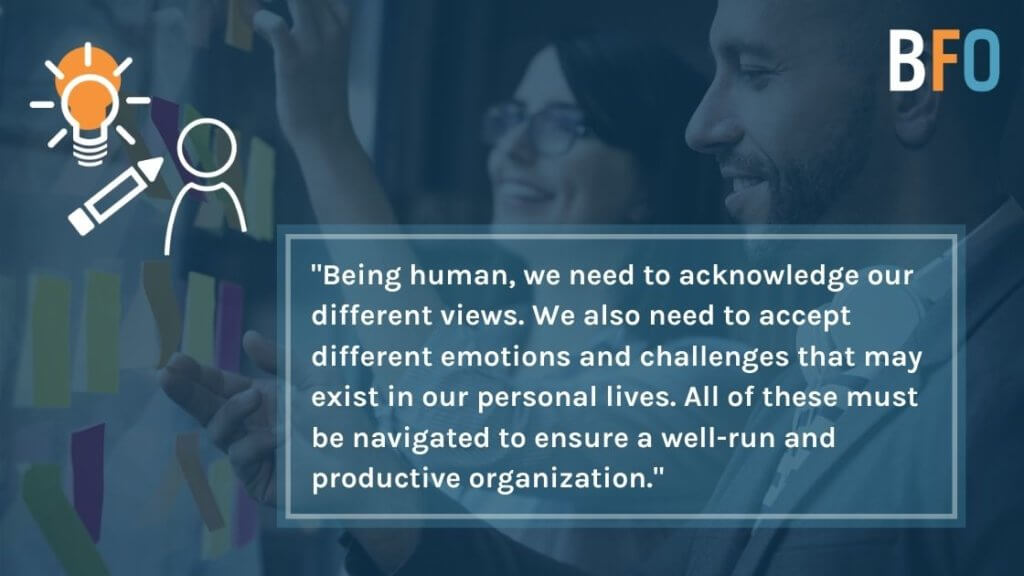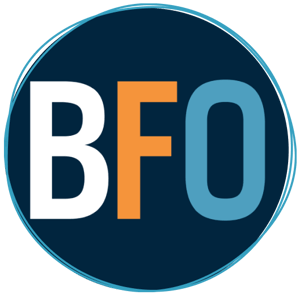

Communication in the workplace is arguably the most important feature of a well-run organization. In order to meet long-term goals, everyone must be on the same page and working toward the same agenda. Day-to-day, misunderstandings can derail success and must be met with confrontation and solutions. Otherwise, small issues can develop into something much larger that might even grow two heads!
Effective communication can be difficult for as few as two individuals. It becomes that much more complicated to identify shared values, offer constructive criticism and navigate alternative perspectives when you’re a business of over twenty people.
At BFO, we’ve implemented several practices to ensure open, honest, and fair communication. Our experience has shown it builds trust between employees, improves client results, and creates an inclusive environment where everyone is encouraged to be themselves, express themselves, and use their natural talents to grow as individuals and advance their careers, all while embracing our values; Be Good to Each Other, Make a Difference, Speak Up Constructively, and Be Good Humans.
We have fostered this environment since our inception, but like any organization run by humans, we’ve overcome pitfalls and roadblocks to get to where we are today. Fortunately, we are now reaping the benefits of our experience and want to share them with you – to help your organization grow, prosper, and promote open communication to improve the lives of your employees, your clients, and your community.
The Danger of Poor Communication: A Case Study
Back in 2009 when BFO was first founded, our executive team realized employee empowerment and job satisfaction were key to succeeding as a business. We implemented principles from the Great Game of Business which led to open-book management to improve transparency between our business and our employees. For a while, everything ran well.
Then, a few years back, morale began to fall. Despite our employee focus, business growth and success, the company culture was, well, at its lowest point ever. Leadership took a step back to evaluate what was going on.
A review of the company uncovered communication and trust were the issues. Managers and employees had gotten comfortable in their silos and rarely associated with other teams. Everyone had become okay with their little world, but long-term vision became fuzzy and productivity dwindled.
How We Broke Free from Negativity and Created Open Communication
Getting people to realize a communication problem exists isn’t easy. In response, management got together for breakfast out of the office. A different venue offered everyone a way to eliminate the potential for those everyday office disruptions, foster communication, and exercise an alternative perspective.
They decided to complete a 2-day management training on productive communication where they reviewed guidelines for safe communication aimed at rebuilding trust with each other. They implemented a strategy for the future, outlining rules, considerations and how-tos for effectively getting past hurdles.
After the initial adjustment period, open communication became a habit at BFO rather than a standard to be achieved. In fact, having a routine method for communicating has been incredibly seamless to maintain. When a new hire comes along, they tend to adapt quickly to ‘speaking the language.’ This is likely because our approach is efficient and productive when it comes to confronting challenges, discussing complex subjects and dealing with misunderstandings.
How We Continue to Improve Communication and Build Trust at BFO
Internal, company-wide communication may be where we started, but we’ve found it isn’t the only place communication and trust can be improved.
For example, let’s say a project ran behind, taking you away from other work, like that client call coming up the following day. You know you’re not prepared. You also know you could rush the analysis and get some hodgepodge reports together. Is that good communication?
In our experience, the answer is no. The client wants – and pays for – your best work. Being transparent with your client (and manager) creates the best communication and trust. You demonstrate your commitment to the client.
Transparency is an integral part of every relationship, be it employee, client, or vendor. Internal or external, we use the following approaches to continuously improve communication and build trust in each of our business relationships.
Working to Speak the Same Language
We like to use math as an example of getting everyone on the same page. Think of the number 9. There are a lot of ways to get to it. You can add 1 + 1 + 1…or you can subtract, multiply, divide – you might get there differently, but what’s important is that you get there. When a conflict of any kind arises, it can be uncomfortable to discuss. It’s not easy for everyone. But, if we focus on the goal of finding a solution, then it gets easier.
Being human, we need to acknowledge our different views. We also need to accept different emotions and challenges that may exist in our personal lives. All of these must be navigated to ensure a well-run and productive organization.
Speaking the same language requires approaching each situation in a constructive, objective way. It requires taking a data-driven approach.
Through data, we can provide direct feedback to the individual in question, rather than through behind-the-back gossip. Focusing on data also sets the right tone. Feedback delivered as an attack won’t be well-received. If people start blaming others or get defensive without any data to support their position the conflict is most likely to become an unproductive argument.
We’ve found that our approach to communicating has increased peer-to-peer accountability because employees understand that we won’t let each other down if we speak openly when something arises. When feedback is given, employees are expected to take ownership and make any discussed changes moving forward. The more we practice this, the more we trust one another to follow through. Open communication, constant improvement, and fostering the feedback loop has become ingrained as part of our culture and it has made us much stronger as a business.
The Clearing Exercise
Even with a culture built around open communication, sh*t happens. When it does, you need to clear the air. We’ve implemented a borrowed methodology (Thanks @Goodr) that is called The Clearing Exercise.
In our experience, it works. Here’s what is involved.
Step 1. Bring the Data.
In any disagreement or conflict, data helps to clear the air and keep everyone speaking the same language. Data provides the demonstrable and supportable details about a situation needed to effectively resolve conflict.
“Jimmy, you’ve showed up 10 minutes late to our meetings three times over the past two weeks” would be an effective way to begin a discussion because these points are non-disputable.
Step 2. Share Feelings
Once we lay out the data, we discuss feelings. You cannot argue that you feel someone is being unfair unless you have first given the data to demonstrate why. It is also important to note that the feelings you share must be specific to the situation. If you have an opinion that you cannot put into constructive criticism based on data, don’t share it.
“I feel that you don’t value my time or our team’s time when you show up late so frequently to meetings” is how you might express your feelings following the facts mentioned previously to Jimmy.
Step 3. Express and Clarify Your Position
This is when the discussion really happens. You have shared your facts and feelings and now Jimmy likely has a response. For example, “I apologize for my absence. I was dealing with some personal stuff on Tuesday and Thursday of last week and then my train was delayed the morning of our meeting this week.”
Once Jimmy has shared his part, it’s important that rather than getting defensive, each party seeks to understand the position of the other. Remember that this is a clearing exercise. The point is to confront the issue and find a solution in the most efficient way possible so that both people can clear the air and return to their jobs.
Step 4. Share Expectations for the Future
Both parties share their expectations for future interactions. You might conclude: “Jimmy, I understand that you were struggling last week and ran into a delay this week. In the future, just notify us if you are running late and mention if you are dealing with distractions that we should be aware of.” This way, we will not run into the same situation again because you have addressed how to handle it in the future.
Things to Keep in Mind
Throughout this entire process, all parties must try to avoid:
1. Blaming the other party
2. Becoming defensive
3. Taking things personally
We are fortunate to have an office committed to open communication, but sometimes situations do arise where a Clearing Exercise is needed. It’s worth noting that a Clearing Exercise is about setting boundaries and expectations between coworkers and is not related to friends or friendship – the two must remain separate.
Promoting a Culture of Open Communication
At BFO, we’ve found a culture of open communication requires more than simply defining best practices for employee interaction. The entire company from its people to its processes must promote open communication, from top to bottom.
To achieve this, we’ve implemented several practices in addition to our clearing exercise. These include:
Open-Book Management
We have open-book financials, inspired by the Great Game of Business model. We meet every week and talk about what is going on in all teams and what is needed from everyone.
Tuesday Stand-Ups and Fifteen-Minute Fridays
The entire company participates in this collaborative time to gather feedback for projects and share departmental news. It follows a framework for coming up with ideas, identifying how they will help, what would be needed to make them happen, and then getting buy-in. It’s also a great way for the entire company to stay informed of what is happening across departments!
Open Floor Plan
The majority of the office features an open-floor plan and the executives’ doors are always open. This environment can get noisy but it fosters collaboration and really ties the social aspect of working in an office.
Emplify
This HR tool helps open communication throughout the company and especially with company executives and department heads through engagement surveys. Employees can be honest, answering anonymous surveys and sharing thoughts on how we can improve the organization from clearer communication to career advancement to not feeling challenged by or enjoying a role.
Final Thoughts
Ultimately, we always try to get the whole team involved in business decisions, defining workplace expectations, and contributing to the culture to ensure maximum involvement and a feeling of inclusion. We spend a lot of time together so we want to make sure we foster an environment that is most conducive to each and every employee.
We know when we do our best and communicate effectively, our employees are happy, our clients get better results, and we contribute to and promote understanding, honesty, and peace in our community and the world we live in.
These are the methods we use to better improve communication at BFO. How have you addressed open communication in your office? What’s worked and what hasn’t? Let us know your thoughts so we can continue to grow and communicate together, openly and honestly.

The BFO Team
Here at BFO, we're always striving to bring you the latest and greatest in digital marketing insights and education. We're not ones to brag, but we've been lucky enough to be featured in all sorts of fancy publications and media outlets, strutting our stuff and showing off our industry expertise.
CATEGORIES
SUBSCRIBE TO OUR BLOG
Stay up to date with the latest industry best practices in digital marketing!























.png?width=339&height=179&name=Webinar%20Banner%20(1).png)



.png?width=339&height=179&name=July%20Webinar%20(Newsletter).png)

.png?width=339&height=179&name=Webinar%20Banner-April-02%20(1).png)
%20(4).png?width=339&height=179&name=Webinar%20Banner-May-02%20(1)%20(4).png)




.png?width=339&height=179&name=March%202023%20Webinar%20Ad%20(autoresponder).png)

















































